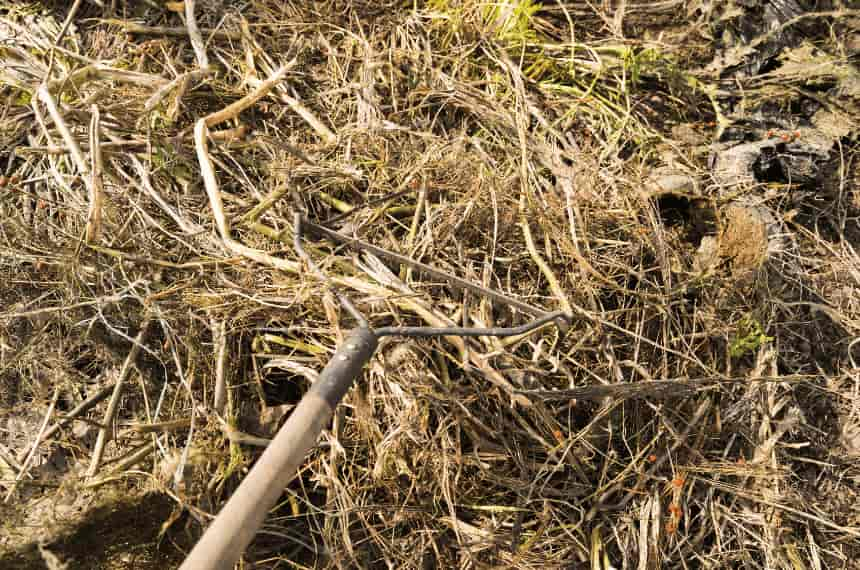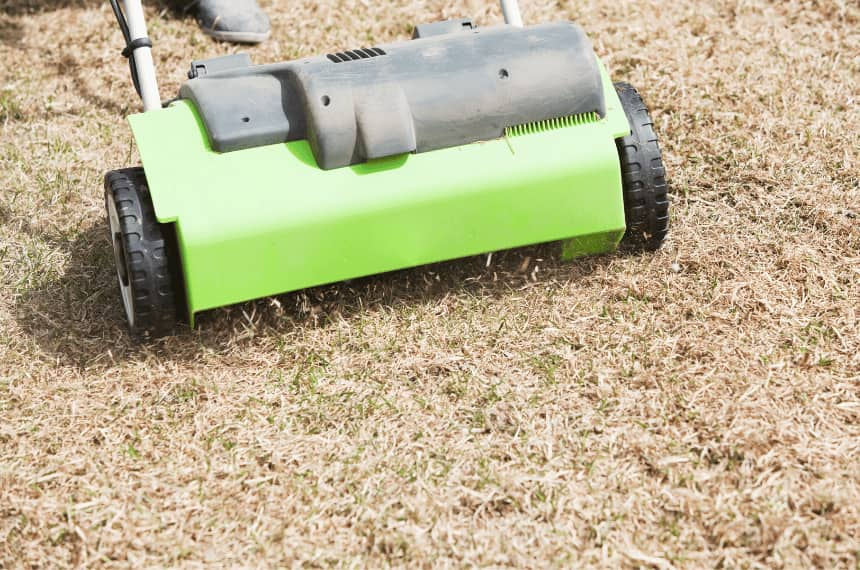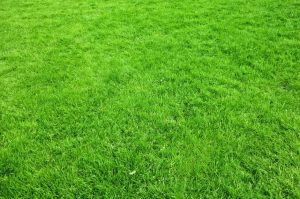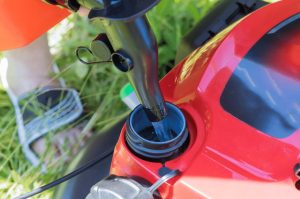If you want a lush, green, and healthy lawn, dethatching it is an essential task.
Dethatching, also known as vertimowing, removes the layer of dead and decaying organic material that accumulates on top of the soil. This material, known as thatch, can suffocate your lawn if left untreated.

What is lawn thatch?
Lawn thatch is a layer of dead organic matter that accumulates on the surface of a lawn over time. It comprises dead grass, leaves, stems, and other debris that have not decomposed completely.
Thatch can be consequential for your lawn as it forms a thick mat on top of the soil, preventing water, air, and nutrients from reaching the grass roots. Essentially, this can lead to a host of problems, such as poor drainage, root rot, and an increased risk of pest infestation.
Furthermore, thatch visually is never an appealing sight, making your lawn look dull and patchy
What is lawn dethatching?
Lawn dethatching is the process of removing the layer of thatch that has built up on your lawn. The thatch is accordingly collected and removed from the lawn, exposing the soil and allowing water, air, and nutrients to penetrate the root zone more effectively.
Signs Your Lawn Needs to be Dethatched
Here are some signs to look out for that indicates you need to dethatch your loan:
- The grass feels spongy or soft underfoot
- The lawn has a thick layer of dead grass or other organic matter at the base
- Water pools on the surface of the lawn and doesn’t penetrate the soil
- Grass roots are shallow and weak
- The lawn has yellow or brown patches
When to dethatch lawn in Australia?
The best time to dethatch a lawn in Australia depends on the type of grass you have and the climate in your region.
Generally, it is best to dethatch warm-season grasses such as buffalo grass, kikuyu, and couch during the late spring or early summer, when the grass is actively growing and can recover quickly. This is usually around October to November in most parts of Australia.
For cool-season grasses such as fescue and ryegrass, the best time to dethatch is in the early autumn or spring, when the grass is growing actively and can recover more easily. This is usually around March to April or September to October. However, monitoring your lawn and only dethatch when necessary is important, as over-dethatching can damage the grass and soil.
What gear do you need to vertimow your lawn?
To vertimow your lawn, you will need a specialised machine called a verticutter or a dethatcher. This machine uses rotating blades or tines to pull up the layer of thatch from the soil’s surface. You can rent a verticutter from a local garden or equipment rental store or hire a professional lawn care company to do the job for you.
In addition to the verticutter, you may also need some basic lawn care equipment, such as a rake or leaf blower, to help remove the excess thatch from the lawn once it has been pulled up. You may also need a lawn mower to cut the grass to the appropriate height before and after dethatching.
Additionally, we always recommend wearing protective gear such as gloves, goggles, and ear protection when using a verticutter, as the machine can be quite loud and may kick up debris.

How to vertimow your lawn
Vertimowing, also known as dethatching, is a process that can help improve your lawn’s health and appearance. Here are the steps you should follow to vertimow your lawn:
- Mow the grass to a shorter height than normal a few days before you plan to vertimow. This will make it easier for the verticutter to pull up the thatch.
- Water the lawn thoroughly the day before you plan to vertimow. This will help to loosen the thatch and make it easier to remove.
- Use a verticutter or dethatcher to pull up the layer of thatch from the soil’s surface. Follow the instructions for your specific machine, and be careful not to damage the grass or soil. It is best to work in a grid pattern, making overlapping passes over the entire lawn to ensure that you remove all of the thatch.
- Once you have finished vertimowing, use a rake or leaf blower to remove the excess thatch from the lawn. You can also leave the thatch on the lawn and mow over it with a bagging mower to collect it.
- Water the lawn thoroughly after vertimowing to help it recover and promote new growth. It is also a good idea to fertilise the lawn to give it the nutrients it needs to thrive.
- Avoid heavy foot traffic on the lawn for a few weeks after vertimowing to allow the grass to recover fully.
Vertimowing can be strenuous and time-consuming, so it may be a good idea to hire a professional lawn care company to do the job for you if you are unsure or do not have the proper equipment.
How often should you Vertimow?
After completing a vertimow, you may be wondering how often you should perform this lawn maintenance technique. The answer depends on various factors, such as the type of grass, the age of the lawn, and the amount of thatch buildup. Here are some general guidelines on how often you should vertimow your lawn:
- Type of grass: Different types of grass have varying growth rates and tendencies to develop thatch. For instance, warm-season grasses such as Bermuda and Zoysia tend to accumulate thatch more quickly than cool-season grasses such as fescue and bluegrass. If you have warm-season grass, you may need to vertimow more frequently than if you have cool-season grass.
- Age of the lawn: Older lawns tend to have more thatch buildup than newer lawns. If your lawn is over five years old, you may need to vertimow every year or two. If your lawn is less than five years old, you may be able to wait longer between vertimowing sessions.
- Amount of thatch buildup: The thickness of the thatch layer is another factor to consider when deciding how often to vertimow. If you notice that the thatch layer is more than a centimetre thick, it’s time to vertimow. If the layer is thinner, you may be able to wait longer.
Generally, it’s best to vertimow in the spring when the grass is actively growing. This allows the lawn to recover more quickly from the stress of vertimowing. However, if your lawn has excessive thatch buildup, you may also need to vertimow during the summer.
Key considerations before dethatching your lawn
Before you dive into dethatching your lawn, remember some important considerations to ensure you achieve the best results. Here are some key things to think about before starting the dethatching process:
- Timing: As mentioned earlier, the best time to dethatch your lawn is during the growing season in the spring or fall. However, avoiding dethatching during extreme heat or drought would be best, as this can stress your lawn and hinder its recovery.
- Equipment: Dethatching requires specialised equipment such as a power rake or vertical mower. You can rent these machines from a gardening or equipment rental store or hire a professional lawn care company to do the job for you. Make sure you choose the right equipment for your lawn type and know how to operate it safely and effectively.
- Thatch thickness: Before dethatching, you should assess the thickness of the thatch layer. You may not need to dethatch if the thatch is less than a centimetre thick. If it is between a centimetre to 2.5 centimetres thick, you can dethatch your lawn without causing too much damage. However, if the thatch is more, you may need to dethatch in stages to avoid damaging the grass roots.
- Grass type: Different grass types have different tolerances for dethatching. Warm-season grasses like Bermuda and Zoysia can handle more aggressive dethatching. In contrast, cool-season grasses like fescue and bluegrass may require a gentler approach.
- Aftercare: Once you have dethatched your lawn, giving it time to recover is important. You should water your lawn thoroughly and avoid mowing it for a few days. You can add fertiliser or topsoil to help the grass recover and grow more vigorously.
In summary, before dethatching your lawn, you should consider the timing, equipment, thickness of the thatch layer, grass type, and aftercare requirements. By considering these factors, you can ensure that your lawn dethatching project is a success and that your lawn remains healthy and vibrant.






